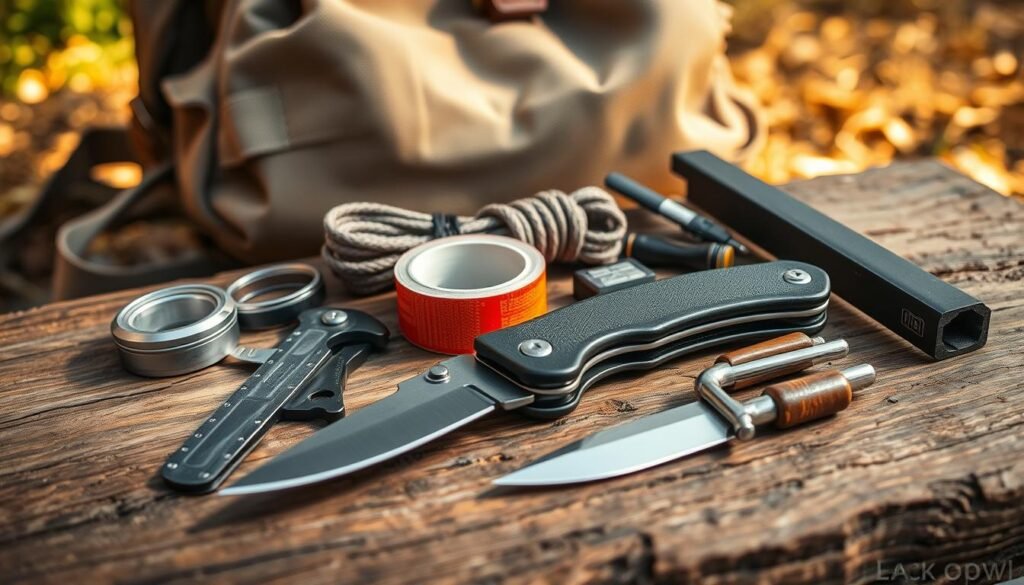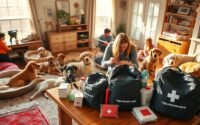Free Bug-Out Bag Templates and Checklists to Download
Proper planning cuts panic and saves lives. You will learn how to assemble a compact pack that prioritizes water, food, shelter, first aid, lighting, power, and clear communication.
This short intro shows why a printable checklist and a ready-to-pack bag reduce stress in an emergency. The right items—water filter, first aid supplies, long-lasting food, a tarp, light sources, and multi-tools—make the difference when seconds count.
We update this resource often, so bookmark it and return for new gear advice and regional tips for wildfire, flood, hurricane, tornado, and earthquake readiness. Use the templates to match your family, car, or solo needs and make sure your load is carryable under pressure.
Key Takeaways
- Start with life-safety items: water, food, shelter, and first aid.
- Use a simple checklist to avoid missing essentials under stress.
- Tailor your setup to local hazards and family needs.
- Organize gear into modules for quick access.
- Keep a rotation schedule so food and batteries stay fresh.
Start Smart: Why Planning Your Bug-Out Bag Matters
When you plan ahead, you trade panic for action and boost your survival odds in a disaster. A clear plan helps you decide fast, pack right, and move with purpose in the first minutes, hours, and days.
Proper planning uses the Survival Rule of 3’s to rank needs: air, shelter, water, then food. Organizing your bag around those time limits makes decisions easier under pressure.
Proper planning principles: apply the Survival Rule of 3’s
- Prioritize items that address immediate threats first.
- Size the pack to your strength so you can carry it when moving.
- Stage a secondary pack in your vehicle for redundancy.
Take preparedness seriously: build confidence before situations escalate
Run practice drills with family, assign roles, and create a one-page quick reference to reduce decision fatigue. Set clear thresholds for when you leave so you act decisively the first time a situation worsens.
| Priority | Timeframe | Action |
|---|---|---|
| Air / Breathing | Minutes | Address injuries; keep airway clear |
| Shelter | Hours | Tarp, emergency blanket, shelter kit |
| Water | Days | Filter, bottles, purification tablets |
| Food | Weeks | High-calorie rations, compact stove |
Make sure your plan is simple, practiced, and updated. Bookmark this page so you return for fresh survival tips and gear changes.
Guide: Downloadable Bug-Out Bag Templates and Checklists
Use a concise 72-hour PDF that prioritizes water, shelter, and first aid so you pack what matters most.
Printable lists typically include 60+ essential items across hydration, medical, food, shelter, lighting, power, communication, documentation, navigation, hygiene, and tools. You can pick solo, family, or vehicle versions that add redundancies or roadside aids as needed.
Download printable 72-hour checklists (PDF) for fast packing
- Sequence tasks so water, first aid, and shelter come first to speed packing.
- Use verification boxes for perishables and batteries to make sure items rotate.
- Keep a printed copy inside the bag list sleeve and a digital copy on your phone.
Family, solo, and vehicle-ready templates you can customize
Customize columns for weight and priority to trim excess and keep your load carryable. Assign family members sections so every category is covered.
| Template | Key additions | Use case |
|---|---|---|
| Solo | Lightweight rations, compact stove | Fast on-foot movement |
| Family | Extra water, larger tarps, duplicate docs | Multiple people, redundancy |
| Vehicle | Jump-start kit, roadside tools | Car staging and longer range |
What a Bug-Out Bag Is and When You’ll Use It
A well-packed emergency kit is a portable plan that keeps you moving for the first critical 72 hours after you leave home. A bug bag is a portable backpack designed to sustain you for at least three days away from your primary shelter.
Definition and purpose
You build this pack to cover life-sustaining needs during an evacuation. Experts keep contents slim and focused on shelter, water, food, first aid, lighting, navigation, and multi-tools. Many lists break gear into about a dozen categories so checks and resupply stay simple.
Real-world triggers
- Power outages that last days and cripple services.
- Wildfire smoke or advancing flames that force fast evacuation.
- Flooding or rising waters that make homes unsafe.
- Earthquakes with aftershocks and damaged roads.
- Civil unrest that creates unsafe movement near your neighborhood.
Plan for portability: size the bag so you can move on foot if needed, stage a vehicle kit if you have one, and keep waterproof ID copies inside. Avoid loading nonessentials that add weight but not survival value.
Hydration First: Water Storage, Filtration, and Purification
Start your hydration plan by choosing durable containers and a proven filtration system you trust.
Proper planning and consideration are two of the more important keys in survival prep. You will want layered water supplies inside your bag so you never rely on one source.
Water bottle, filter, and purification tablets: build redundancy
Pack a hard-wearing water bottle plus a lightweight backup. Add a field-proven filter for streams and taps, then include purification tablets for extra peace of mind.
Estimating needs for 72 hours and on-the-move filtration
Plan at least one gallon per person per day and adjust for heat or heavy exertion. Consider a collapsible bladder to boost capacity when you reach a refill point.
- Mark resupply routes on printed maps to find public sources when phones fail.
- Stow resealable bags to separate clean gear and waterproof documents.
- Pack an N95 mask for smoke or dust while you treat water.
“Make sure you practice your filtration workflow before you need it.”
Audit water and tablet expiration dates regularly. Keep electrolyte packets, avoid sugary drinks that dehydrate, and rehearse refilling under low-light conditions.
Calorie-Dense Food and Simple Cooking Gear
Prioritize lightweight, high-calorie food that you can eat cold to save time and fuel. Proper planning and consideration are two of the more important keys in survival prep. Take them seriously.
Non-perishables to pack
- Stock MREs, energy bars, beef jerky, and ration bars that work cold or heat quickly.
- Label rotation dates so you make sure nothing expires unnoticed.
- Account for allergies and dietary needs now to avoid unusable food later.
Compact cooking tools
Include a small stove with fuel tablets, a stainless pot or cup, a spork, and heat-resistant gloves. These items let you boil water and heat meals safely near a small fire if needed.
“Practice lighting your stove and boiling water in the wind so you can prepare meals under less-than-ideal conditions.”
| Category | Recommended | Why |
|---|---|---|
| Rations | MREs, bars, jerky | High calories, long shelf life |
| Cook kit | Stove, fuel, pot, spork | Lightweight, multi-use |
| Safety | Gloves, resealable bags | Handle heat, reduce scent |
Shelter, Sleeping, and Weather Protection
A lightweight tent or a well-rigged tarp can be the difference between rest and exposure. Start by choosing layers that block wind, shed rain, and trap body heat. Space blankets and Mylar shelters are light, retain warmth, and repel water, so add one to your core kit.
Light tents, tarps, and reflective options
Pick a tent that balances weight with durability for your likely conditions. A compact tarp works as a ground liner, rain shield, or quick lean-to when trees are available.
Guy lines and lightweight stakes help secure shelter in wind or on rocky ground. Practice rigging tarps and pitching a tent in low light so you move quickly under pressure.
Sleep system selection
Choose a sleeping bag rated for your coldest expected nights and pair it with an insulating pad to stop ground chill. Matching bag warmth to climate keeps you from carrying extra bulk.
Versatile attire and rapid access
Pack a rain jacket or poncho, a bandanna or hat, extra socks, underwear, and sturdy work gloves. These clothing pieces cut blisters, shield you from wet weather, and help when you gather wood or clear debris.
Stage shelter items near the top of your pack so you can deploy them fast if daylight fades or a storm appears. Proper planning and consideration are two of the more important keys in survival prep. Take them seriously.
“Make sure you practice pitching your tent and rigging tarps in the dark so you can set up quickly under stress.”
- Build layers: tent/tarp + space blanket for wind and heat retention.
- Match sleeping bag rating to expected temperatures and use a pad for insulation.
- Carry a tarp for ground cover and emergency shelters.
- Include rainproof clothing, spare socks, and work gloves for hands-on tasks.
First Aid and Medical Readiness You Can Rely On
Your health supplies should be staged for instant use during high-stress moments. In an emergency, quick access to basic care reduces complications and speeds recovery. Keep a compact first aid kit near the top of your bag so you can reach it in low light.
Core contents for a compact kit
Carry essentials: adhesive bandages, gauze pads, antibiotic ointment, antiseptic wipes, scissors, tweezers, cotton swabs, and OTC pain and fever meds. Add a small first aid manual as a quick reference so memory does not slow care.
Bleed control and trauma items
Include a dedicated bleed control set: a tourniquet, large pressure dressings, cold pack, splint material, and latex-free gloves. These items help you address severe bleeding and stabilize a wound in a survival situation.
Personal prescriptions and special needs
Pack prescriptions plus backups and paper copies of scripts. Add pediatric supplies or items for older adults, like spare glasses or hearing aid batteries. Date-check meds on a schedule and rotate them so you make sure nothing expires.
“Run simple medical drills—tourniquet placement, wound packing—so you can respond decisively when it matters.”
- Stow nitrile gloves in a visible pouch at the top of the bag.
- Include sunscreen, insect repellent, and burn cream for environment-related injuries.
- Practice basic first aid skills regularly to build confidence before a real emergency.
Tools, Repairs, and Fire: Multi-Tool, Knife, Duct Tape, Paracord
Proper planning and consideration are two of the more important keys in survival prep. Take them seriously when you choose the tools that live in your bag.
Pick a quality multi-tool and a fixed or folding knife so you have cutting, prying, and fieldcraft capability in one compact set. Protect blades with sheaths and keep them easy to access but secure while you move.

Multi-functional essentials for shelter building and fixes
Carry 50–100 feet of paracord to rig tarps, hang food, and lash repairs. Use bright tape or paint on small items so you can find them at night or in grass.
Include duct tape plus a small roll of repair tape. Patch holes, seal containers, or improvise splints when medical supplies run low.
Fire starters and waterproof matches for reliable ignition
Layer ignition: a ferro rod, a lighter, and waterproof matches give redundant fire options in wet, windy conditions.
- Practice one-hand fire starting and knife safety so you stay effective if injured or wearing gloves.
- Stage a small sewing kit and safety pins to fix straps and clothing in the field.
- Consider a compact shovel for digging catholes, clearing drainage, or making a safe fire pit.
“Check tools each audit cycle, replacing exhausted tinder, dull blades, and soaked matches.”
Lighting, Power, and Communication Essentials
Lighting and reliable charging let you act after dark and keep vital devices online when outages last. Plan lights and charging so you can navigate, treat wounds, and stay informed during a prolonged event.
Proper planning and consideration are two of the more important keys in survival prep. Take them seriously.
Flashlight and headlamp with spare batteries
You carry a bright flashlight plus a headlamp for hands-free tasks. Use the headlamp when you need both hands to treat injuries or rig shelter.
- Store spare batteries in a waterproof case and test them during audits.
- Prefer red-light modes to preserve night vision and reduce attention when moving.
- Add chem lights as passive, all-weather lighting and signaling options.
Solar power bank and durable charging cables
Pack a solar-charged battery bank and rugged cables to keep phones and radios running when grid power is out. Label cables for each device so you find the right one quickly inside your bag.
AM/FM radio, cell phone, and walkie talkies for updates
Include an AM/FM weather radio to receive official updates if cell networks overload. Add compact walkie talkies for team coordination when spread out or when silence is needed.
“Keep critical comms high in the bag, protected in dry bags, and checked before leaving shelter.”
- Practice silent comms and simple hand signals as a radio backup.
- Set a charging routine so devices stay ready across multiple days.
- Keep these items near the top of your bag so you can reach them quickly in an emergency.
Security, Navigation, and Critical Documents
Keep a compact set of nonlethal defense items and reliable maps for fast decisions in a crisis.
Defense options where lawful
You carry pepper spray where legal as a nonlethal option for distance and speed. A small spray fits an external pocket for quick access without adding bulk to your bag.
Consider soft armor inserts only if local laws allow and if you accept the extra weight. A knife or taser may be useful, but secure them to prevent accidental loss or discharge.
Maps, compass, and route planning
Keep printed maps and a baseplate compass in a top pouch. Practice plotting bearings and marking primary and alternate routes before a disaster.
Plan routes that avoid flood zones and closed bridges. Rehearse resection and handrail techniques so you can navigate when landmarks are gone.
Waterproof documents and backups
Store waterproof copies of IDs, passports, medical records, insurance papers, and spare keys in a sealed pouch. Keep encrypted digital backups on a secure drive.
Make sure documents are separated and labeled so you find them under stress.
| Item | Placement | Why |
|---|---|---|
| Pepper spray | External pocket | Quick, nonlethal defense for people or animals |
| Soft armor insert | Inner sleeve | Extra protection where lawful; weighs more |
| Maps & compass | Top compartment | Reliable navigation when electronics fail |
| Waterproof docs | Sealed pouch | Prove ID and access services after a bug event |
| Whistle & reflective patch | External attachment | Signaling in low visibility |
Personalize, Maintain, and Stay Updated
Small seasonal swaps and quick audits mean your gear works when a real event arrives. Keep changes simple so you actually perform them. Label items, note refill dates, and test fit with a full load before you trust any pack for travel.
Seasonal swaps and regional risks across the United States
Swap cold-weather clothing, hand warmers, and heavier sleeping layers in winter. Replace bulky insulation with lighter rain gear in summer.
Tune supplies for regional threats: hurricanes on coasts, wildfires in the West, and tornadoes in the Plains. Adjust water and shelter items to match local needs.
Pets, kids, and accessibility needs: tailoring your bag
Build family kits that include pet food, vaccination records, and child comfort items like favorite toys or Rx meds. Add accessibility gear for mobility or medical devices so everyone can move safely.
Audit cadence: check gear, rotate food/water, and bookmark for new templates
Set a quarterly audit to check batteries, rotate food and water, and refresh hygiene items. Keep a printed list and a synced digital checklist that matches what is actually packed.
Proper planning and consideration are two of the more important keys in survival prep. Take them seriously. We continually update this blog. So, bookmark it and come back frequently for the latest survival information.
| Focus | Action | Frequency |
|---|---|---|
| Clothing & shelter | Seasonal swaps for warmth or rain | Before season change |
| Family & pet kits | Add meds, food, records, comfort items | Quarterly |
| Consumables | Rotate water, food, and tablets; label dates | Every 3 months |
| Fit & function | Walk test with full load; adjust straps | Biannual or after changes |
Conclusion
Proper planning and consideration are two of the more important keys in survival prep. Close this process with a simple ritual: verify items, label compartments, and rehearse packing so you act fast in an emergency.
Experts agree a well-prepared kit with checked essentials—hydration, shelter, food, first aid, lighting, power, communications, navigation, and documents—changes the first 72 hours of a disaster.
Store both printed and digital copies of your checklist, right-size bags for each family member, and commit to a quarterly review. We continually update this blog, so bookmark it and return for new templates and post-incident lessons.
You’ll leave confident, knowing your preparation today protects life tomorrow in any bug situation.
FAQ
What is the purpose of a 72-hour kit and who should have one?
A 72-hour kit is designed to sustain you for three days after an evacuation or major disruption. You should have one if you live in areas prone to wildfires, floods, earthquakes, hurricanes, or if you face civil unrest. Make versions for yourself, your family, and your vehicle so you can move quickly and stay self-sufficient until help or normal services return.
How do I prioritize items when packing for limited space?
Prioritize life-sustaining essentials first: water, food, shelter, first aid, and navigation. Then add communication and power, tools for repairs and fire, and personal documents. Use the Survival Rule of 3’s—air, water, shelter, then food—to rank items, and pack multi-use gear like a multi-tool, duct tape, and paracord to reduce bulk.
How much water should I include and what’s the best way to purify on the move?
Aim for at least one gallon per person per day for drinking and basic hygiene—so three gallons for 72 hours. Carry a refillable water bottle, a lightweight filter such as Sawyer Mini or LifeStraw, and purification tablets as backup. If on the move, use a filter with a wide flow rate and carry a collapsible reservoir to store treated water.
What food types give the most calories and durability for emergency situations?
Choose calorie-dense, non-perishable items like MREs, high-calorie energy bars, nut butters, jerky, and meal kits designed for camping. Pick goods with long shelf life and minimal prep. Include a compact cook system or a small stove and fuel if you expect to heat or rehydrate meals.
What should a compact first aid kit include beyond basic bandages?
Beyond bandages and antiseptic, include trauma items like a tourniquet, large sterile dressings, hemostatic gauze, nitrile gloves, and a CPR mask. Add OTC meds (pain relievers, antihistamines), antibiotic ointment, blister care, and space for personal prescriptions. Regularly check expiration dates and restock as needed.
How often should I check and rotate items in my kit?
Audit your kit every six months. Rotate food and water by replacing soon-to-expire items, check batteries and charging cables, test flashlights and radios, and inspect tents, sleeping bags, and clothing for wear. Update documents, prescriptions, and any seasonal clothing swaps to match current regional risks.
What tools are essential for shelter and repairs in an emergency?
Essential tools include a reliable multi-tool or fixed-blade knife, a compact shovel, duct tape, paracord, a sturdy tarp or lightweight tent, and a roll of repair tape. Fire starters like a ferro rod and waterproof matches are critical. These items help with quick shelter building, gear repairs, and basic site maintenance.
Are pepper spray and body armor appropriate for inclusion in a kit?
Pepper spray can be a legal, non-lethal deterrent in many U.S. jurisdictions—check local laws before adding it. Body armor inserts offer added protection but may be heavy and regulated; only include them if legal and practical for your situation. Prioritize situational awareness and non-confrontational escape routes.
How do I keep important documents safe and accessible?
Store waterproof, laminated copies of IDs, passports, medical records, insurance info, and emergency contacts in a waterproof pouch or sealed bag. Keep digital backups on an encrypted USB drive and a secure cloud account. Assign a grab-and-go folder so you can retrieve critical documents quickly during evacuation.
How should I customize a kit for children, pets, or mobility needs?
For kids, include age-appropriate snacks, comfort items, and any medications. For pets, pack food, water, a leash, vaccination records, and a lightweight bowl. For mobility or accessibility needs, add spare batteries for medical devices, adaptive tools, extra prescription meds, and contact information for caregivers. Tailor weight and carry options to your mobility constraints.
What power and communication tools should I bring for emergencies?
Include a high-capacity solar power bank, durable charging cables, an LED headlamp and flashlight with spare batteries, and a hand-crank or solar AM/FM radio. Carry a fully charged cell phone, portable charger, and a pair of walkie-talkies if you need short-range communication without cell service.
Where can I find reliable printable checklists and templates to help pack quickly?
Trusted sources include FEMA, the American Red Cross, and outdoor brands like REI or NOLS. Many organizations offer printable 72-hour checklists and customizable templates for family, solo, and vehicle packs. Use these lists as a baseline and adapt them to your climate, health needs, and regional hazards.


